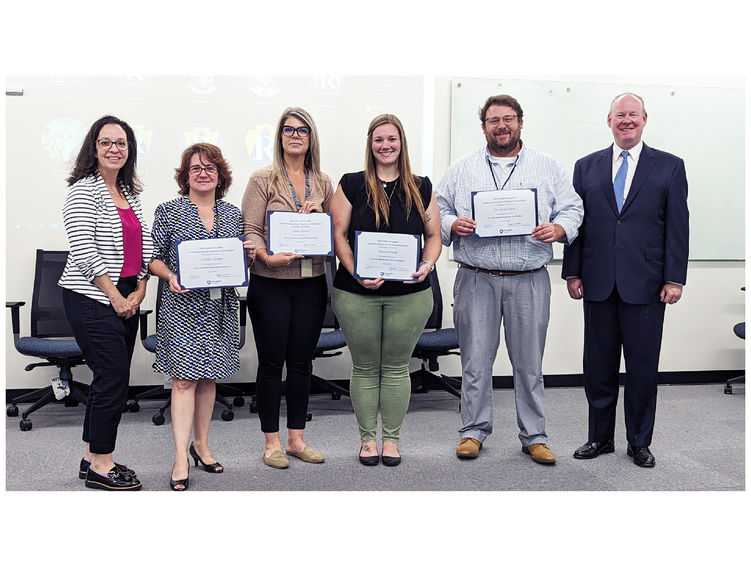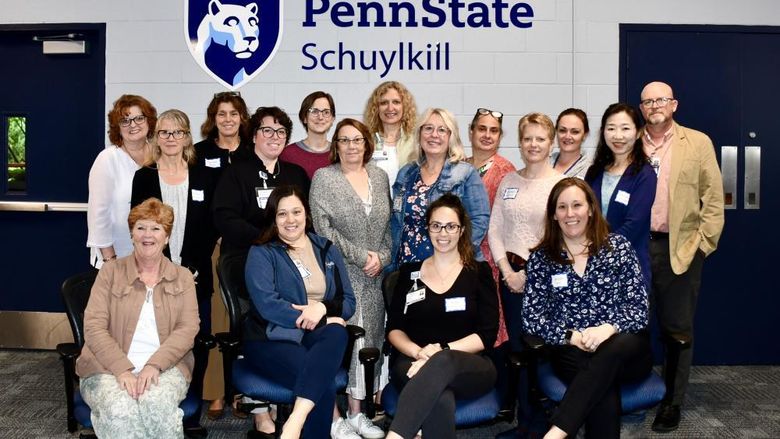
Group of employees from Pa. Dept. of Revenue receiving their Green Belt certifications after completing Lean Six Sigma programming.
SCHUYLKILL HAVEN, Pa. — Penn State Schuylkill recently partnered with the Pennsylvania Department of Revenue to offer continuing education units (CEUs) to state employees training in an efficiency program known as Lean Six Sigma.
Lean Six Sigma is a process improvement approach focused on cutting waste and increasing quality to keep organizations competitive. The green belt certification program utilizes a comprehensive and disciplined learning model for improvement, where participants learn how to meet their company’s business objectives through applying the 8-step problem solving methodology. As part of the program, participants learn how to direct Lean Six Sigma projects and optimize improvements from the learned techniques and skills.
Teaming up with the Pennsylvania Department of Revenue
The program’s focus on collaboration and efficiency in all processes is part of what makes the methodology pair well with a state organization like the Pennsylvania Department of Revenue, a multifaceted government agency that is relied upon by the Commonwealth to collect general tax revenue — which affects every business and individual in the state of Pennsylvania.
Four employees for the Department of Revenue — Jesse Drayer, Caitlinn Gomes, Theresa Powell and Laura Ritter — recently earned their Green Belt certification through the Lean Six Sigma program in late August, with another four students not far behind. Part of that certification requirement included implementing process improvement projects within their roles and measuring the outcomes.
Projects completed by Drayer, Gomes, Powell and Ritter focused on:
- Optimizing the new employee orientation process
- Reducing the time needed to fill out required audit forms and the margin of error in the documentation
- Eliminating the unnecessary routing of signature approvals for overtime for employees in specific classifications
- Reducing the timeline to docket paper petitions for business taxes
Applying methodology to processes and driving results
“Our partnership with Penn State Schuylkill has been tremendously beneficial for us as an agency based on pure time savings alone,” said Dorty Theis, the director of strategic operations for the Pennsylvania Department of Revenue. “However, the real benefit we’ve observed is being able to witness the development and growth in our employees that went through this program. We watched them take the concepts and methodologies they learned and apply them to their work, all while carrying out their job responsibilities and serving taxpayers. Their accomplishments have been inspiring and their newly acquired skills will be able to pay dividends well into the future.”
Streamlining the onboarding process for new employees and the department overall
Drayer’s project centered around optimizing the new employee orientation process, which was typically completed within 30 days of the new hire beginning their role. Using the framework learned in the program, Drayer streamlined the process for new hires in the Department of Revenue’s Bureau of Imaging and Document Management by implementing a centralized orientation process for distribution and management. These improvements included:
- Reducing redundancies in orientation materials
- Updating paperwork with visual indicators on important documents that need to be filed
- Creation of a standard orientation packet and checklist
- Internal spreadsheet tracking when documents were last updated
- Training for supervisors on the new orientation packets and process
With these improvements in place, the new employee orientation process saw a 98% decrease in the time it takes to properly orient an employee, from a 30-day window to one day, with the expectation that the paperwork is completed and filed within a week of the new hire’s start date. While Drayer’s project focused on one bureau within the department, many of these improvements and the lessons learned are being leveraged as part of building out a new department-wide onboarding experience for all new employees.
Reducing time needed to fill out necessary audit forms
Gomes’s process improvement relates to reducing the amount of time it takes for a waiver to be filled out for an audit, as well as reducing the margin of error within the document. The amount of time the Department of Revenue has to complete an audit is dictated by the laws for each tax type, and an audit waiver extends that time for both the Department of Revenue and the taxpayer, so that they can effectively review records before the audit reaches the point of assessment or determination of tax.
To smooth the process out, Gomes created a form and corresponding letter that auto-fills taxpayer information from their system into the form, taking the process of filling out the form from 60 minutes to 20 minutes, which reduced the timeline significantly — saving the department 32 workdays per year and reducing the margin of error in the documentation from 22% to nearly 0%.
Optimizing the way hourly employees enter overtime
Powell’s project eliminated more than 225 hours of work by eliminating unnecessary routing of signatures for approvals for employees of certain classifications that work overtime hours. Initially, the process would take 12 weeks to complete due to the need for physical signatures from various department managers for paperwork to process. With the introduction of electronic forms with signature availability, there is no longer a need for physical signatures and multiple forms. Overtime can now be processed on an as-needed basis.
Now, this process takes one week or less to complete, and two to three business days in terms of receiving the appropriate signatures.
Introducing new technologies to improve docketing of paper petitions
Ritter’s process improvement examined the way in which paper petitions were docketed. The Board of Appeals petition form was updated to be compliant with optical character recognition technology, allowing useful data from the petition to be captured upon the petition being scanned. Capturing data improved accuracy of the petitions and alleviated the need for Tax Appeals Reviewers to physically input all of the data needed to complete the docketing process. To help ensure that the transition to this new model went well, training tutorials were created to guide taxpayers through the process, and in turn created a more consistent model for taxpayers to follow — with language that is utilized on other Department notices received by taxpayers.
This project reduced the paper petition docketing time from 60 days to 7 days, which is a time savings of 334 workdays a year. This project also introduced a management dashboard that tracks workflow in real time, allowing management to evaluate performance standards and determine how resources should be allocated. While the initial scope of this project was limited to business taxes, the success of the Lean Six Sigma project has led to it being expanded to appeals for all Pennsylvania tax types.





